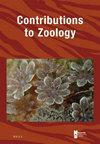卡罗琳海山和南海两种新的信息线海绵的系统发育
IF 2.1
2区 生物学
Q1 ZOOLOGY
引用次数: 0
摘要
本文报道了二新种。标本采集自中国南海和西北太平洋卡洛琳海山。与它的同属植物不同的是,它表现出大的微两栖体,鞭状和微弯曲的微弯曲体和小的刺状微弯曲体。phonemoides curvipentactin sp. 11 .具有特殊的五角形嵴,末端呈圆形或锥形,末端呈弯曲的针状射线,五角形嵴弯曲,使其易于与同类植物区分。同时对28S rDNA和16S rDNA基因的部分序列进行扩增,以确定这两个新种的科属归属,并探讨费龙属植物的系统地位。本文章由计算机程序翻译,如有差异,请以英文原文为准。
Phylogeny of two new pheronematid sponges from the Caroline Seamount and South China Sea
Two new species of genus Pheronemoides are described in this study. The Specimens were collected from the South China sea and the Caroline seamount in the northwestern Pacific Ocean. Pheronemoides crustiformis sp. nov. differs from its congeners in exhibiting large microamphidiscs, whip-like and slightly bent microuncinates and small spiny microdiactins. Pheronemoides curvipentactin sp. nov. possesses special pentactine atrialia with round terminal or tapering terminal curved pinular rays and crooked pentactins, making it easily distinguishable from its congeners. Partial sequences of the 28S rDNA and 16S rDNA genes were also amplified to confirm the family assignment of the two new species and to explore the systematic status of Pheronemoides.
求助全文
通过发布文献求助,成功后即可免费获取论文全文。
去求助
来源期刊

Contributions to Zoology
生物-动物学
CiteScore
4.00
自引率
4.50%
发文量
16
审稿时长
>12 weeks
期刊介绍:
Contributions to Zoology solicits high-quality papers in all systematics-related branches of comparative zoology (including paleozoology). Preference will be given to manuscripts dealing with conceptual issues and to integrative papers (e.g., ecology and biodiversity, morphology and phylogeny and character state evolution, phylogeny and historical biogeography, systematics and bioinformatics, bioinformatics and biodiversity, habitat disturbance and biogeography, etc.). Reviews and alpha-taxonomic contributions are considered for publication, but acceptance will depend on their high quality and exceptional nature.
 求助内容:
求助内容: 应助结果提醒方式:
应助结果提醒方式:


